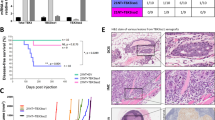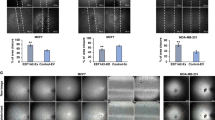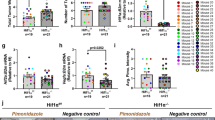Abstract
Hypoxia-elicited adaptations of tumor cells are essential for tumor growth and cancer progression. Although ample evidence exists for a positive correlation between hypoxia-inducible factors (HIFs) and tumor formation, metastasis and bad prognosis, the function of the HIF-α protein stability regulating prolyl-4-hydroxylase domain enzyme PHD2 in carcinogenesis is less well understood. In this study, we demonstrate that downregulation of PHD2 leads to increased tumor growth in a hormone-dependent mammary carcinoma mouse model. Tissue microarray analysis of PHD2 protein expression in 281 clinical samples of human breast cancer showed significantly shorter survival times of patients with low-level PHD2 tumors over a period of 10 years. An angiogenesis-related antibody array identified, amongst others, amphiregulin to be increased in the absence of PHD2 and normalized after PHD2 reconstitution. Cultivation of endothelial cells in conditioned media derived from PHD2-downregulated cells resulted in enhanced tube formation that was blocked by the addition of neutralizing anti-amphiregulin antibodies. Functionally, amphiregulin was regulated on the transcriptional level specifically by HIF-2 but not HIF-1. Our data suggest that PHD2/HIF-2/amphiregulin signaling has a critical role in the regulation of breast tumor progression and propose PHD2 as a potential tumor suppressor in breast cancer.
This is a preview of subscription content, access via your institution
Access options
Subscribe to this journal
Receive 50 print issues and online access
$259.00 per year
only $5.18 per issue
Buy this article
- Purchase on Springer Link
- Instant access to full article PDF
Prices may be subject to local taxes which are calculated during checkout





Similar content being viewed by others
References
Aebersold DM, Burri P, Beer KT, Laissue J, Djonov V, Greiner RH et al. (2001). Expression of hypoxia-inducible factor-1α: a novel predictive and prognostic parameter in the radiotherapy of oropharyngeal cancer. Cancer Res 61: 2911–2916.
Balamurugan K, Luu VD, Kaufmann MR, Hofmann VS, Boysen G, Barth S et al. (2009). Onconeuronal cerebellar degeneration-related antigen, Cdr2, is strongly expressed in papillary renal cell carcinoma and leads to attenuated hypoxic response. Oncogene 28: 3274–3285.
Barnard JA, Graves-Deal R, Pittelkow MR, DuBois R, Cook P, Ramsey GW et al. (1994). Auto- and cross-induction within the mammalian epidermal growth factor-related peptide family. J Biol Chem 269: 22817–22822.
Barth S, Nesper J, Hasgall PA, Wirthner R, Nytko KJ, Edlich F et al. (2007). The peptidyl prolyl cis/trans isomerase FKBP38 determines hypoxia-inducible transcription factor prolyl-4-hydroxylase PHD2 protein stability. Mol Cell Biol 27: 3758–3768.
Brown JM, Wilson WR . (2004). Exploiting tumour hypoxia in cancer treatment. Nat Rev Cancer 4: 437–447.
Bruick RK, McKnight SL . (2001). A conserved family of prolyl-4-hydroxylases that modify HIF. Science 294: 1337–1340.
Camenisch G, Tini M, Chilov D, Kvietikova I, Srinivas V, Caro J et al. (1999). General applicability of chicken egg yolk antibodies: the performance of IgY immunoglobulins raised against the hypoxia-inducible factor 1α. FASEB J 13: 81–88.
Chan DA, Kawahara TL, Sutphin PD, Chang HY, Chi JT, Giaccia AJ . (2009). Tumor vasculature is regulated by PHD2-mediated angiogenesis and bone marrow-derived cell recruitment. Cancer Cell 15: 527–538.
Chokki M, Mitsuhashi H, Kamimura T . (2006). Metalloprotease-dependent amphiregulin release mediates tumor necrosis factor-alpha-induced IL-8 secretion in the human airway epithelial cell line NCI-H292. Life Sci 78: 3051–3057.
Couvelard A, Deschamps L, Rebours V, Sauvanet A, Gatter K, Pezzella F et al. (2008). Overexpression of the oxygen sensors PHD-1, PHD-2, PHD-3, and FIH Is associated with tumor aggressiveness in pancreatic endocrine tumors. Clin Cancer Res 14: 6634–6639.
Elston EW, Ellis IO . (1993). Method for grading breast cancer. J Clin Pathol 46: 189–190.
Epstein AC, Gleadle JM, McNeill LA, Hewitson KS, O'Rourke J, Mole DR et al. (2001). C. elegans EGL-9 and mammalian homologs define a family of dioxygenases that regulate HIF by prolyl hydroxylation. Cell 107: 43–54.
Erez N, Milyavsky M, Eilam R, Shats I, Goldfinger N, Rotter V . (2003). Expression of prolyl-hydroxylase-1 (PHD1/EGLN2) suppresses hypoxia inducible factor-1α activation and inhibits tumor growth. Cancer Res 63: 8777–8783.
Franovic A, Holterman CE, Payette J, Lee S . (2009). Human cancers converge at the HIF-2α oncogenic axis. Proc Natl Acad Sci USA 106: 21306–21311.
Giusti C, Desruisseau S, Ma L, Calvo F, Martin PM, Berthois Y . (2003). Transforming growth factor beta-1 and amphiregulin act in synergy to increase the production of urokinase-type plasminogen activator in transformed breast epithelial cells. Int J Cancer 105: 769–778.
Ivan M, Haberberger T, Gervasi DC, Michelson KS, Gunzler V, Kondo K et al. (2002). Biochemical purification and pharmacological inhibition of a mammalian prolyl hydroxylase acting on hypoxia-inducible factor. Proc Natl Acad Sci USA 99: 13459–13464.
Jaakkola P, Mole DR, Tian YM, Wilson MI, Gielbert J, Gaskell SJ et al. (2001). Targeting of HIF-α to the von Hippel-Lindau ubiquitylation complex by O2-regulated prolyl hydroxylation. Science 292: 468–472.
Jokilehto T, Rantanen K, Luukkaa M, Heikkinen P, Grenman R, Minn H et al. (2006). Overexpression and nuclear translocation of hypoxia-inducible factor prolyl hydroxylase PHD2 in head and neck squamous cell carcinoma is associated with tumor aggressiveness. Clin Cancer Res 12: 1080–1087.
Kato H, Inoue T, Asanoma K, Nishimura C, Matsuda T, Wake N . (2006). Induction of human endometrial cancer cell senescence through modulation of HIF-1α activity by EGLN1. Int J Cancer 118: 1144–1153.
Lamber EP, Horwitz AA, Parvin JD . (2010). BRCA1 represses amphiregulin gene expression. Cancer Res 70: 996–1005.
Le Bras A, Lionneton F, Mattot V, Lelievre E, Caetano B, Spruyt N et al. (2007). HIF-2α specifically activates the VE-cadherin promoter independently of hypoxia and in synergy with Ets-1 through two essential ETS-binding sites. Oncogene 26: 7480–7489.
Lee KA, Lynd JD, O'Reilly S, Kiupel M, McCormick JJ, LaPres JJ . (2008). The biphasic role of the hypoxia-inducible factor prolyl-4-hydroxylase, PHD2, in modulating tumor-forming potential. Mol Cancer Res 6: 829–842.
Lee S, Nakamura E, Yang H, Wei W, Linggi MS, Sajan MP et al. (2005). Neuronal apoptosis linked to EglN3 prolyl hydroxylase and familial pheochromocytoma genes: developmental culling and cancer. Cancer Cell 8: 155–167.
Lee SB, Huang K, Palmer R, Truong VB, Herzlinger D, Kolquist KA et al. (1999). The Wilms tumor suppressor WT1 encodes a transcriptional activator of amphiregulin. Cell 98: 663–673.
Luetteke NC, Qiu TH, Fenton SE, Troyer KL, Riedel RF, Chang A et al. (1999). Targeted inactivation of the EGF and amphiregulin genes reveals distinct roles for EGF receptor ligands in mouse mammary gland development. Development 126: 2739–2750.
Ma L, Gauville C, Berthois Y, Millot G, Johnson GR, Calvo F . (1999). Antisense expression for amphiregulin suppresses tumorigenicity of a transformed human breast epithelial cell line. Oncogene 18: 6513–6520.
Martinez-Lacaci I, Saceda M, Plowman GD, Johnson GR, Normanno N, Salomon DS et al. (1995). Estrogen and phorbol esters regulate amphiregulin expression by two separate mechanisms in human breast cancer cell lines. Endocrinology 136: 3983–3992.
Maxwell PH, Wiesener MS, Chang GW, Clifford SC, Vaux EC, Cockman ME et al. (1999). The tumour suppressor protein VHL targets hypoxia-inducible factors for oxygen-dependent proteolysis. Nature 399: 271–275.
Mazzone M, Dettori D, Leite de Oliveira R, Loges S, Schmidt T, Jonckx B et al. (2009). Heterozygous deficiency of PHD2 restores tumor oxygenation and inhibits metastasis via endothelial normalization. Cell 136: 839–851.
McBryan J, Howlin J, Napoletano S, Martin F . (2008). Amphiregulin: role in mammary gland development and breast cancer. J Mammary Gland Biol Neoplasia 13: 159–169.
Metzen E, Stiehl DP, Doege K, Marxsen JH, Hellwig-Bürgel T, Jelkmann W . (2005). Regulation of the prolyl hydroxylase domain protein 2 (phd2/egln-1) gene: identification of a functional hypoxia-responsive element. Biochem J 387: 711–717.
O'Reilly SM, Leonard MO, Kieran N, Comerford KM, Cummins E, Pouliot M et al. (2006). Hypoxia induces epithelial amphiregulin gene expression in a CREB-dependent manner. Am J Physiol Cell Physiol 290: C592–C600.
Panico L, D'Antonio A, Salvatore G, Mezza E, Tortora G, De Laurentiis M et al. (1996). Differential immunohistochemical detection of transforming growth factor α, amphiregulin and CRIPTO in human normal and malignant breast tissues. Int J Cancer 65: 51–56.
Plowman GD, Green JM, McDonald VL, Neubauer MG, Disteche CM, Todaro GJ et al. (1990). The amphiregulin gene encodes a novel epidermal growth factor-related protein with tumor-inhibitory activity. Mol Cell Biol 10: 1969–1981.
Pouysségur J, Dayan F, Mazure NM . (2006). Hypoxia signalling in cancer and approaches to enforce tumour regression. Nature 441: 437–443.
Qi CF, Liscia DS, Normanno N, Merlo G, Johnson GR, Gullick WJ et al. (1994). Expression of transforming growth factor α, amphiregulin and cripto-1 in human breast carcinomas. Br J Cancer 69: 903–910.
Semenza GL . (2003). Targeting HIF-1 for cancer therapy. Nat Rev Cancer 3: 721–732.
Shoyab M, McDonald VL, Bradley JG, Todaro GJ . (1988). Amphiregulin: a bifunctional growth-modulating glycoprotein produced by the phorbol 12-myristate 13-acetate-treated human breast adenocarcinoma cell line MCF-7. Proc Natl Acad Sci USA 85: 6528–6532.
Stiehl DP, Wirthner R, Koditz J, Spielmann P, Camenisch G, Wenger RH . (2006). Increased prolyl 4-hydroxylase domain proteins compensate for decreased oxygen levels. Evidence for an autoregulatory oxygen-sensing system. J Biol Chem 281: 23482–23491.
Takeda K, Cowan A, Fong GH . (2007). Essential role for prolyl hydroxylase domain protein 2 in oxygen homeostasis of the adult vascular system. Circulation 116: 774–781.
Theurillat JP, Ingold F, Frei C, Zippelius A, Varga Z, Seifert B et al. (2007). NY-ESO-1 protein expression in primary breast carcinoma and metastases: correlation with CD8+ T-cell and CD79a+ plasmacytic/B-cell infiltration. Int J Cancer 120: 2411–2417.
Wagenaar GT, ter Horst SA, van Gastelen MA, Leijser LM, Mauad T, van der Velden PA et al. (2004). Gene expression profile and histopathology of experimental bronchopulmonary dysplasia induced by prolonged oxidative stress. Free Radic Biol Med 36: 782–801.
Wanner RM, Spielmann P, Stroka DM, Camenisch G, Camenisch I, Scheid A et al. (2000). Epolones induce erythropoietin expression via hypoxia-inducible factor-1α activation. Blood 96: 1558–1565.
Warnecke C, Griethe W, Weidemann A, Jurgensen JS, Willam C, Bachmann S et al. (2003). Activation of the hypoxia-inducible factor-pathway and stimulation of angiogenesis by application of prolyl hydroxylase inhibitors. FASEB J 17: 1186–1188.
Wenger RH . (2002). Cellular adaptation to hypoxia: O2-sensing protein hydroxylases, hypoxia-inducible transcription factors, and O2-regulated gene expression. FASEB J 16: 1151–1162.
Wenger RH, Stiehl DP, Camenisch G . (2005). Integration of oxygen signaling at the consensus HRE. Sci STKE 306: re12.
Wiesener MS, Turley H, Allen WE, Willam C, Eckardt KU, Talks KL et al. (1998). Induction of endothelial PAS domain protein-1 by hypoxia: characterization and comparison with hypoxia-inducible factor-1α. Blood 92: 2260–2268.
Willmarth NE, Ethier SP . (2008). Amphiregulin as a novel target for breast cancer therapy. J Mammary Gland Biol Neoplasia 13: 171–179.
Wu S, Nishiyama N, Kano MR, Morishita Y, Miyazono K, Itaka K et al. (2008). Enhancement of angiogenesis through stabilization of hypoxia-inducible factor-1 by silencing prolyl hydroxylase domain-2 gene. Mol Ther 16: 1227–1234.
Xue J, Li X, Jiao S, Wei Y, Wu G, Fang J . (2010). Prolyl hydroxylase-3 is downregulated in colorectal cancer cells and inhibits IκKβ, independent of hydroxylase activity. Gastroenterology 138: 606–615.
Zhang Q, Gu J, Li L, Liu J, Luo B, Cheung HW et al. (2009). Control of cyclin D1 and breast tumorigenesis by the EglN2 prolyl hydroxylase. Cancer Cell 16: 413–424.
Zhong H, De Marzo AM, Laughner E, Lim M, Hilton DA, Zagzag D et al. (1999). Overexpression of hypoxia-inducible factor 1α in common human cancers and their metastases. Cancer Res 59: 5830–5835.
Acknowledgements
We thank P Spielmann for excellent technical assistance, K Wollenick, TF Lüscher, PJ Ratcliffe (University of Oxford, Oxford, UK), SB Lee (National Institutes of Health, Bethesda, MD, USA), DA Chan (University of California, San Francisco, CA, USA) for gifts of antibodies, cells and plasmids and D Neri (Institute of Pharmaceutical Sciences, ETH Zürich, Switzerland) for helpful discussions. This work was supported by the Swiss National Science Foundation and Krebsliga des Kantons Zürich (GC).
Author information
Authors and Affiliations
Corresponding author
Ethics declarations
Competing interests
The authors declare no conflict of interest.
Additional information
Supplementary Information accompanies the paper on the Oncogene website
Supplementary information
Rights and permissions
About this article
Cite this article
Bordoli, M., Stiehl, D., Borsig, L. et al. Prolyl-4-hydroxylase PHD2- and hypoxia-inducible factor 2-dependent regulation of amphiregulin contributes to breast tumorigenesis. Oncogene 30, 548–560 (2011). https://doi.org/10.1038/onc.2010.433
Received:
Revised:
Accepted:
Published:
Issue Date:
DOI: https://doi.org/10.1038/onc.2010.433
Keywords
This article is cited by
-
The multifaceted role of EGLN family prolyl hydroxylases in cancer: going beyond HIF regulation
Oncogene (2022)
-
Prolyl hydroxylase 2 silencing enhances the paracrine effects of mesenchymal stem cells on necrotizing enterocolitis in an NF-κB-dependent mechanism
Cell Death & Disease (2020)
-
Hypermethylated gene ANKDD1A is a candidate tumor suppressor that interacts with FIH1 and decreases HIF1α stability to inhibit cell autophagy in the glioblastoma multiforme hypoxia microenvironment
Oncogene (2019)
-
Loss of amphiregulin reduces myoepithelial cell coverage of mammary ducts and alters breast tumor growth
Breast Cancer Research (2018)
-
Hypoxia-inducible factor 2-alpha-dependent induction of amphiregulin dampens myocardial ischemia-reperfusion injury
Nature Communications (2018)



